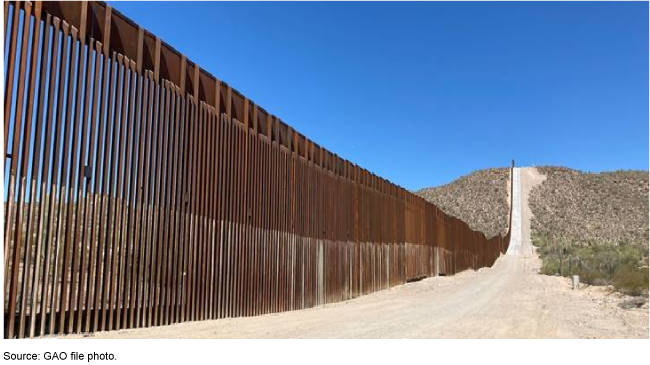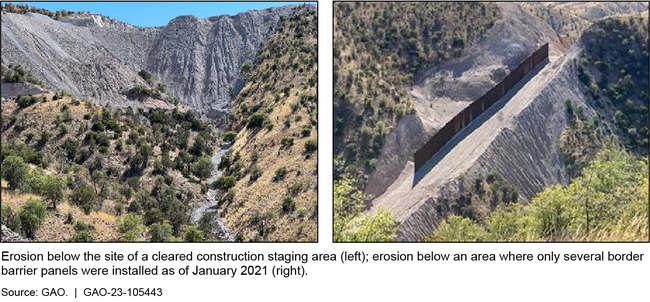Southwest Border: Additional Actions Needed to Address Cultural and Natural Resource Impacts from Barrier Construction
Fast Facts
From 2017 through January 2021, federal agencies built about 450 miles of barriers along the U.S. Southwest border. To expedite construction, they waived federal environmental and other laws.
The construction harmed some cultural and natural resources, for example, by blasting at a tribal burial site and altering water flows.
Before building, the Department of Homeland Security assessed some potential effects of the construction. But federal officials and stakeholders said they didn't get enough information from DHS to give meaningful input.
Our recommendations include evaluating lessons learned from this process to inform any future work.

Highlights
What GAO Found
The Department of Homeland Security's (DHS) U.S. Customs and Border Protection (CBP) and the Department of Defense (DOD) installed about 458 miles of border barrier panels across the southwest border from January 2017 through January 2021. Most (81 percent) of the miles of panels replaced existing barriers. The agencies installed over 62 percent of barrier miles on federal lands, including on those managed by the Department of the Interior. Interior and CBP officials, as well as federally recognized Tribes and stakeholders, noted that the barriers led to various impacts, including to cultural resources, water sources, and endangered species, and from erosion.
Examples of Natural Resource Impacts from Barrier Construction (May 2022)

Since the administration paused border barrier construction in January 2021, CBP has prioritized efforts to address safety hazards left at incomplete project sites, such as removing exposed rebar. In addition, CBP and Interior have worked together to identify actions to mitigate the impacts on federal lands. As the agencies are both involved in addressing these impacts, they could benefit from clearly defining their roles and responsibilities for doing so and jointly identifying the costs and time frames to complete all of the identified mitigation actions, consistent with collaboration leading practices. Documenting a joint strategy that includes these inputs could help CBP and Interior better ensure that key resource impacts of border barrier construction are mitigated and that decision makers have the information needed to allocate resources.
Before proceeding with barrier construction from 2017 to 2021, CBP took steps to assess the potential impacts of such construction, while relying on waivers of cultural and natural resource-related laws to expedite construction. For example, CBP solicited input from land management agencies, Tribes, and the public. Interior and tribal officials and stakeholders told GAO that CBP's information was not sufficiently detailed to facilitate meaningful input. They provided suggestions to GAO for improving CBP's assessments. CBP has not evaluated lessons learned from its assessments. Doing so could help the agency better identify potential impacts of any future projects.
Why GAO Did This Study
To help address illegal cross-border activity, the federal government has constructed hundreds of miles of physical barriers along the southwest border. This included federal lands managed by Interior where important cultural and natural resources are located. DHS and DOD used legal authorities to waive various cultural and natural resource-related laws in constructing border barriers from January 2017 through January 2021. A presidential proclamation paused construction in January 2021.
GAO was asked to review border barrier impacts to cultural and natural resources. This report reviews (1) border barrier construction from January 2017 through January 2021 and associated impacts, (2) actions taken since January 2021 to address impacts, and (3) CBP and DOD assessments of potential impacts from construction conducted from 2017 to 2021. GAO analyzed CBP data and reviewed CBP and DOD assessments and plans. GAO also interviewed officials from federal agencies, Tribes, and stakeholders selected because of their proximity to, or expertise with, resource protection along the border.
Recommendations
GAO is making three recommendations, including that CBP and Interior document a joint strategy to mitigate resource impacts from barrier construction and that CBP evaluate lessons learned from its assessments of potential cultural and natural resource impacts. The agencies agreed with these recommendations.
Recommendations for Executive Action
| Agency Affected | Recommendation | Status |
|---|---|---|
| United States Customs and Border Protection | The Commissioner of CBP should document, jointly with Interior, a strategy to mitigate cultural and natural resource impacts from border barrier construction that defines agency roles and responsibilities for undertaking specific mitigation actions; identifies the costs, associated funding sources, and time frames necessary to implement them; and specifies when agencies are to consult with Tribes. (Recommendation 1) |
CBP agreed with this recommendation. In a discussion with CBP in June 2024, CBP told us they had worked on a joint strategy with Interior. In September 2024, CBP provided information that CBP's Commissioner signed the strategy, and that the strategy was with Interior for final review and approval. At that time, they anticipated the strategy to be approved and finalized by March 2025. In March 2025, CBP said they had completed their portion of the joint strategy but are awaiting approval from Interior. They are targeting December 2025, for it to be approved and finalized. We will continue to monitor CBP's actions in response to this recommendation and evaluate them when complete.
|
| Department of the Interior | The Secretary of the Interior should document, jointly with CBP, a strategy to mitigate cultural and natural resource impacts from border barrier construction that defines agency roles and responsibilities for undertaking specific mitigation actions; identifies the costs, associated funding sources, and time frames necessary to implement them; and specifies when agencies are to consult with Tribes. (Recommendation 2) |
Interior agreed with this recommendation. In December 2024, Interior provided information that they met with CBP to clear additional language on the joint Strategy. They indicated Interior could complete its approval and signatory process in 2025. We will continue to monitor Interior's actions in response to this recommendation and evaluate them when complete.
|
| United States Customs and Border Protection | The Commissioner of CBP, with input from Interior, DOD, Tribes, and stakeholders, should evaluate lessons learned from its prior assessments of potential impacts. (Recommendation 3) |
CBP agreed with this recommendation. In December 2024, CBP reported that on May 29, 2024, the United States District Court for the Southern District of Texas issued a permanent injunction prohibiting U.S. Customs and Border Protection (CBP) from using its Fiscal Years (FY) 2020 and 2021 barrier system appropriations for, among other things, mitigation, and remediation efforts. Prior to the injunction, CBP used its FYs 2020-2021 barrier system appropriations to fund mitigation activities related to barrier construction. According to CBP, it also used those funds to draft a lessons learned document which, in March 2025, officials told us was mostly complete. CBP officials previously provided information in June 2024 they had worked with Interior ahead of the preliminary injunction to generate information for the lessons learned report. Officials said that they had planned to solicit input from the Department of the Interior, Tribes, and other stakeholders on the lessons learned. However, CBP officials stated that the injunction impacts the completion of the lessons learned document, and the agency does not have funds to evaluate barrier construction and complete the lessons learned document. CBP provided a new estimated completion date of February 2027.
|
